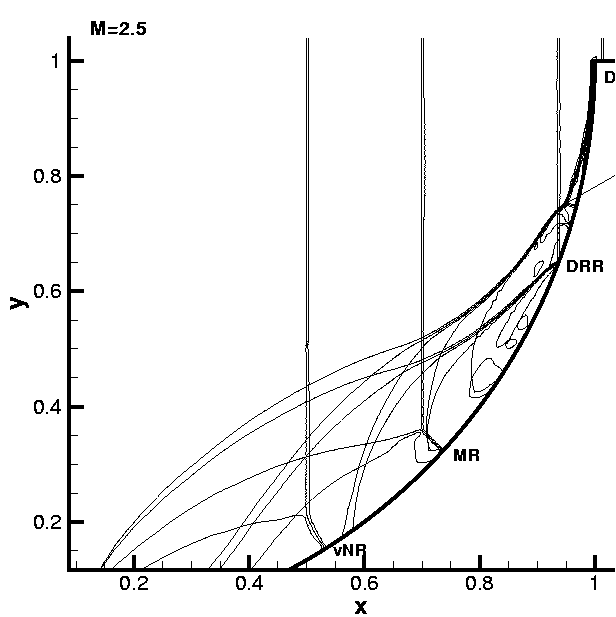I.V.Krassovskaya, M.K.Berezkina
Ioffe Institute, St. Petersburg, 194021 Russia
Unsteady shock wave reflection can partially be obtained when a planar shock wave propagating with a constant velocity encounters a non-straight surface. Most attention has been paid to the shock wave reflection off convex and concave cylindrical surfaces. In the case of convex reflecting surface, the reflection pattern changes from regular to irregular. For a concave reflecting surface, the reflection pattern changes from irregular to regular. The experimental and numerical data show that for cylindrical reflecting walls the RR - MR transition angles do not agree with the travsition angles predicted by the von Neumann theory for the straight wedges. To this day the question of determination of transition parameters has been one of the unanswered questions associated with reflection of shock waves off convex/concave cylindrical surfaces.
The paper deals with the analisys of the mechanism of formation of unsteady reflection configurations. To provide a better understanding of the physical mechanism of formation of shock-wave reflections off concave and convex cylindrical surfaces, numerical simulations of shock wave reflection off a polyhedron inscribed in a cylinder and a polyhedron circumscribed around a cylinder have been carried out. It is shown that reflection configurations forming in unsteady flows look like ideal ones observed in pseudo-steady flows but are not determined by the incident shock Mach number and the local wedge angle, and thus cannot be described with the use of the von Neumann theory. Hence, parameters of RR - MR transition in unsteady flows cannot be compared with the transition parameters in pseudo-steady flows. The most important thing is that not a single incident shock but shock-wave configuration is involved in the process of interaction with the reflecting surface. For a convex cylindrical reflecting surface, a regular reflection configuration arises at t=0. The reflection point is located on the surface and it will move along the wall in the next moments. It means that both incident and reflected waves interact with the surface simultaneously. The new reflection configurations will be formed not only according to the incident shock Mach number and local wadge angle but according to the parameters behind the reflected shock of the previous RR configuration.
Numerical calculations of shock wave reflections off a concave cylindrical wall were conducted for various incident shock Mach numbers (M = 1.2, 1.3, 1.4, 1.5, 2.5, 5.0). Figs. 1 - 3 show the histories of the reflection processes for M = 1.2, M = 2.5 and M = 5.0, respectively. For weak shock wave (Fig.1), the consecution of reflection configuration is: vNR > MR > RR followed by the formation of the RR structure with an additional triple point on the reflected wave This pattern is known as transitioned regular reflection (TRR).

It should be emphasized that in this case the TRR configuration followed RR. For M = 2.5 this wave configuration arises immediately after the termination of MR, i. e. in the instant of transition from MR to RR.

The numerical results show that MR > RR transition does not necessarily imply the formation of a TRR. For this reason we believe that the term "double regular reflection" (DRR) - regular reflection with the additional triple point on the reflected wave - would be more suitable than the term TRR. The nature of this triple point is carefully investigated.
For strong incident shock wave (Fig.3) with supersonic flow behind it, the process of incident shock flow deflection markedly affects the process of shock reflection. As a result of interference of these processes, the configuration of double Mach reflection (DMR) is formed at early stages of reflection. Subsequently, the RR configuration with two additional triple points on the reflected wave is formed.

Numerical data of shock wave reflection off convex/concave cylindrical walls have shown unambiguously that the evolution of reflection configurations is determined by the curvature of the reflecting wall. Transition angles between different kinds of unsteady reflection configurations depend on the shape of the reflecting wall and differ from transition angles obtained for pseudo-steady reflection.

